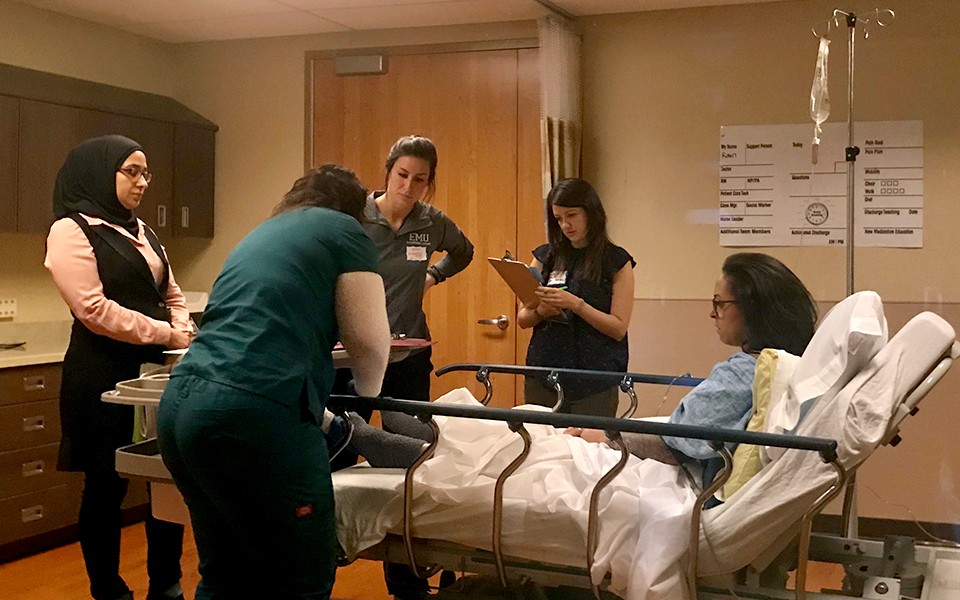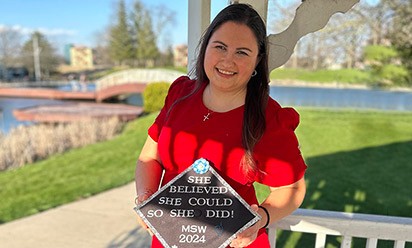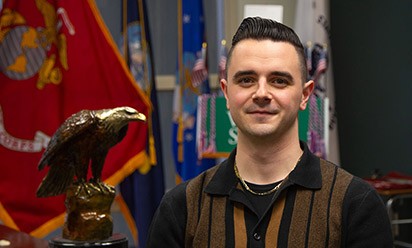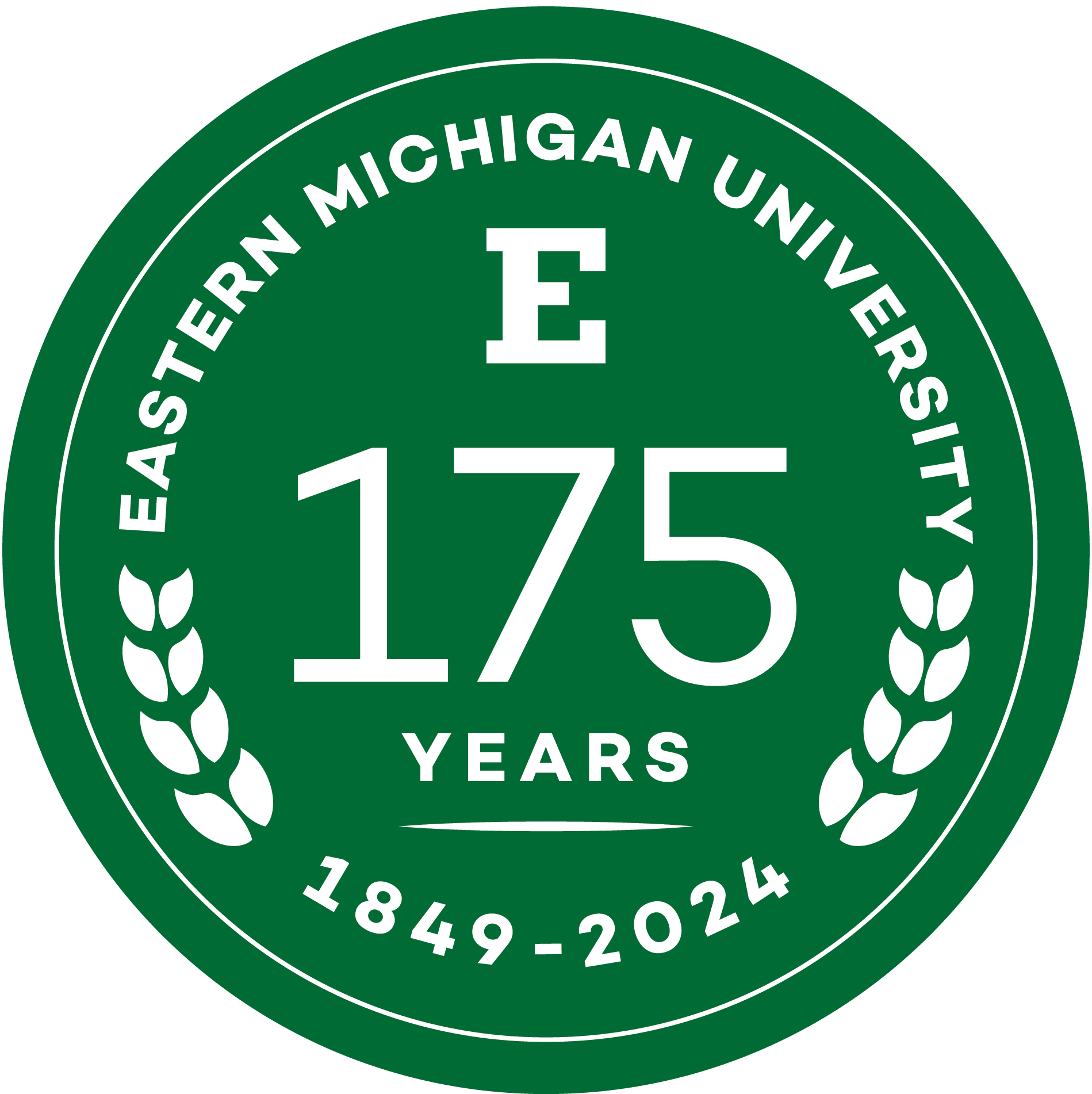Eastern Michigan University students learn vivid lessons regarding the need for communicative, integrated patient care
Eastern students from seven separate healthcare specialties in the College of Health and Human Services participate in a day of patient simulations and teachable moments at St. Joseph Mercy Ann Arbor Hospital and the Rackham facility on the EMU campus

YPSILANTI – “It’s been a bad day.”
“This whole surgery thing is a little hard to believe.”
Pretty logical statements from a patient who had collapsed at a grandson’s baseball game, had been taken to the hospital and now was facing possible hip surgery after a bad fall in the hospital room bathroom.
Hearing and reacting to such sentiments were students in both graduate and undergraduate health-based programs at Eastern Michigan University, part of dozens of soon-to-be professionals who participated in a day of scenario practice and review with simulated patients Friday, Nov. 15 at the patient simulation facilities at the Rackham Building on the EMU campus and at nearby St. Joseph Mercy Ann Arbor Hospital.
Students from many programs collaborate
The third annual EMU Interprofessional Education Simulation Day combined students from a variety of health programs, including nursing, physician assistant, dietetics, orthotics and prosthetics, occupational therapy, health administration, and social work.
The day is a centerpiece in the culture and focus at the EMU College of Health and Human Services (CHHS) on interprofessional education (IPE) – the idea that patients benefit most from integrated care that blends the efforts of professionals from various areas.
In one simulation this year, students were to help treat and then come up with a discharge plan for a patient who had collapsed at a grandson’s baseball game, perhaps due to dehydration, and, then had badly fallen while using the patient room bathroom after being admitted to the hospital. Surgery was ultimately required, with the students talking to the patient in simulated scenarios before and after the surgery.
Prior to studying their case and associated charts and x-rays and then entering the simulation room, students were reminded of key elements in simulated care, such as:
“Don’t be afraid to make a mistake.”
“Learn from each other.”
“You can’t go wrong in simply always talking to the patient.”
Putting the patient at ease
Groups of students from different professions would first huddle before talking to the patient, and would then engage in dialogue intended to put the patient at ease, explain the situation and help guide treatment. A sample conversation:
“Hello, Mr. Taylor, do you know where you are?”
“At St. Joe’s Hospital.”
“Do you know why you are here?”
“I remember being at my grandson’s baseball game.”
“Yes. Are you feeling anxiety that you might have surgery?”
“If you mean am I nervous, yes I am.”
“What is your pain, on the scale of 1-10?”
In debriefing after the simulations, students noted a variety of lessons learned, including that it helps to talk to the other professionals beforehand and that doing so helps you offer a calm presence to the patient.
Students reported learning from each other, such as the understanding from dietetics that one can get water (and avoid dehydration) from a variety of sources, including fruit such as watermelon. Or the possible need for social work or occupational therapy to become deeply involved after surgery occurs, to help ensure resumption of a satisfying and normal life.
"I thought this event was extremely beneficial," said Daniella Diaz, a student in the nursing program. "It helped put into perspective what my role is as a nurse when other professions are around me. I really enjoyed the dynamic between all of the disciplines and how we were all able to bring something different to the table to create a quality patient care experience."
Students took part in either morning or afternoon simulations that were broken into two parts. After participating in one of two simulations, students gathered with faculty in a lecture room to share impressions, insights and lessons learned.
Professors Linda Myler and Kathy Seurynck, co-directors of the nursing simulation labs at EMU and organizers of the day’s program along with Jacob Lindquist, a professor of orthotics and prosthetics, led the discussions.
Laying the professional groundwork
“Having this day is very, very valuable for (the students) to be able to see what other people do (in such a setting),” Seurynck says. “To talk to other students in their profession – we’re hoping this carries on to their practice.”
“This day allows us to get students who have never been there before into a hospital patient care setting,” Myler said. “This simulation fulfills some of the standards we want to actually give students before they enter their practice.
“EMU students can set themselves apart by noting they’ve participated in such an inter-professional simulation.”
Lindquist said it's difficult for patients to receive comprehensive care if they or other health profesionals don't know what services are available.
"Part of the beauty of this event is to allow acute care professionals to see what happens to their patients once they leave the hospital," he said. "They gain a better understanding of the rehabilitation process and learn when and to whom they should provide referrals in the future."
About Eastern Michigan University
Founded in 1849, Eastern is the second oldest public university in Michigan. It currently serves nearly 18,000 students pursuing undergraduate, graduate, specialist, doctoral and certificate degrees in the arts, sciences and professions. In all, more than 300 majors, minors and concentrations are delivered through the University's Colleges of Arts and Sciences; Business; Education; Engineering and Technology; Health and Human Services; and, its graduate school. EMU is regularly recognized by national publications for its excellence, diversity, and commitment to applied education. For more information about Eastern Michigan University, visit the University's website.
November 20, 2019
Written by:
Geoff Larcom
Media Contact:
Geoff Larcom
glarcom@emich.edu
734-487-4400
More Stories

Eastern Michigan University awards Summer Research and Creative Activity Grants.

Eastern Michigan University to launch new Bachelor of Business Administration in Financial Planning and Wealth Management degree.

Eastern Michigan University empowers student-faculty collaboration with Undergraduate Symposium Research Fellow Awards.

Eastern Michigan University senior Raya Lasiewski inspires hope and healing through personal journey with eating disorder.

Veteran exceeds limits to becoming an Eastern Michigan University graduate.

